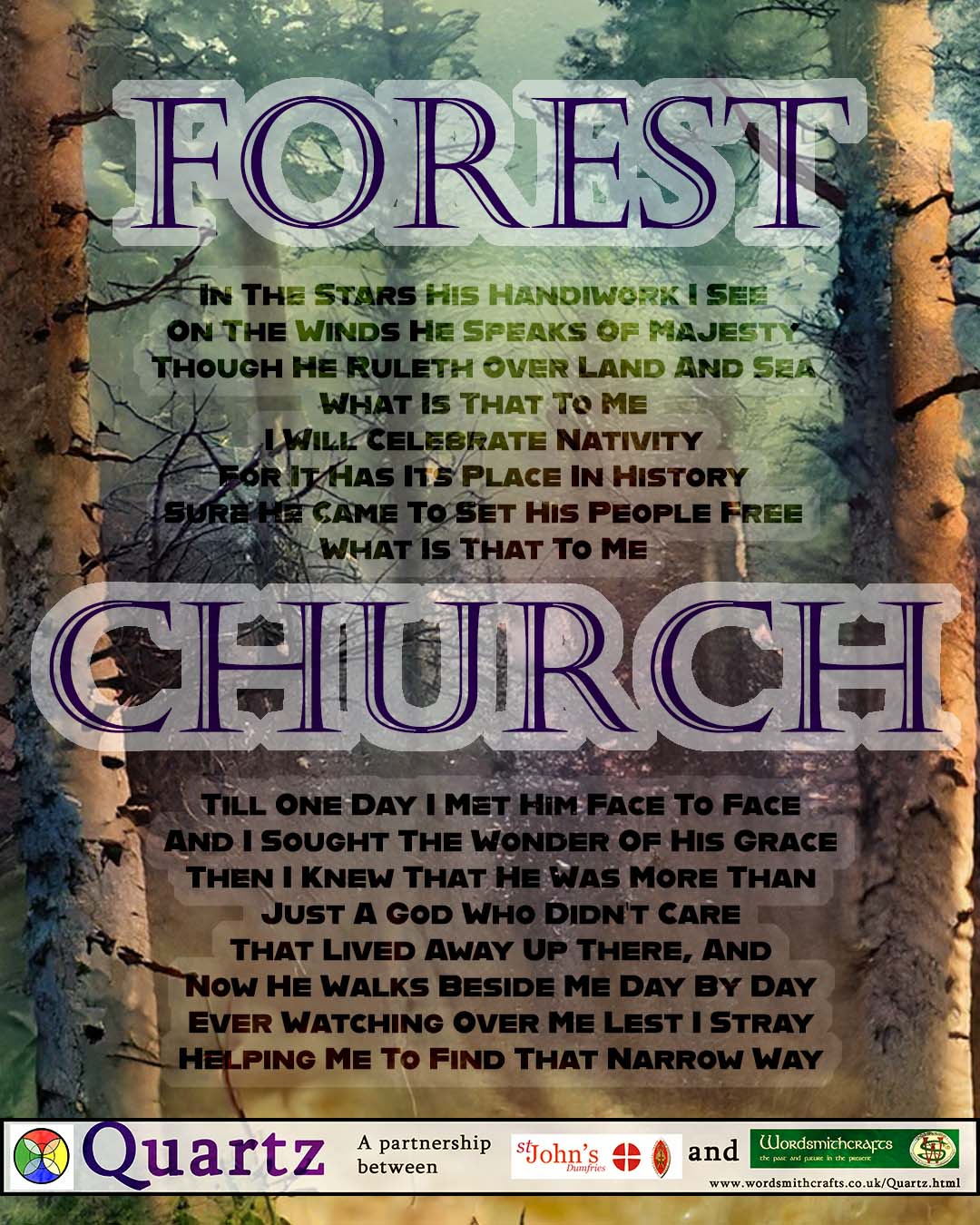What is Forest Church?
Click this link to skip to a general introduction to the concept …
What does Quartz Forest Church look like?
We have met once a month for over two years now. We have seen the leaves fall from the trees, grow and now rest on the ground again. We have started to become acquainted with the landscape of the Crichton estate and find favourite spots. We have watched trees being planted and have said goodbye to the covering provided by those who have been felled
Please join us on the 3rd Sunday of the month. Our usual meeting point is outside the Crichton chapel at 2pm. Dress for the weather! We adapt what we do to suit the people who gather and respond to the place we are meeting.
In addition to the regular monthly meetings we have also started to do something special about four times a year. You can read about these in the past activities section, or by searching for posts with the category Forest Church
Join the mailing list to find out about things before they happen, or continue reading to find out more.
Quartz Forest Church on the Blog
- Forest Church Dec 2025We are not gathering as Forest Church this month. Instead of our usual 3rd Sunday meet up, people are sending in photos of their experiences of God where they are. A common theme that arises while we discuss Forest Church is the relationship between “nature” and “not nature”. As humans we are always part of… Read more: Forest Church Dec 2025
- December Forest Church
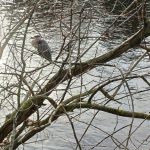 We have decided not to meet as Quartz Forest Church in December. It is a busy time, and there is a lot going on in St Johns. Instead, please send in you glimmers where you become aware of meeting with Jesus in creation. Links to what else is going on in the Church would be… Read more: December Forest Church
We have decided not to meet as Quartz Forest Church in December. It is a busy time, and there is a lot going on in St Johns. Instead, please send in you glimmers where you become aware of meeting with Jesus in creation. Links to what else is going on in the Church would be… Read more: December Forest Church - November Forest Church
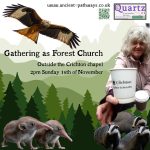 Quartz gathering as Forest Church November 2025 We will meet at 2pm outside the Crichton chapel on the 16th of November. Please dress for the weather! We adapt what we do to accommodate anyone who comes and the weather we find. Peace We will meet in Peace and make peace by meeting. Whether you consider… Read more: November Forest Church
Quartz gathering as Forest Church November 2025 We will meet at 2pm outside the Crichton chapel on the 16th of November. Please dress for the weather! We adapt what we do to accommodate anyone who comes and the weather we find. Peace We will meet in Peace and make peace by meeting. Whether you consider… Read more: November Forest Church - QFC Oct 25
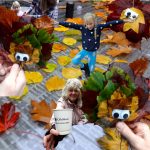 It was a bit of a dreich day when we gathered, but that didn’t dampen proceedings. We practiced looking at the trees, and we read from the bible. As the day was colder than usual this gathering was a bit more active than the contemplative speculation we often default to! Is the a dry wit… Read more: QFC Oct 25
It was a bit of a dreich day when we gathered, but that didn’t dampen proceedings. We practiced looking at the trees, and we read from the bible. As the day was colder than usual this gathering was a bit more active than the contemplative speculation we often default to! Is the a dry wit… Read more: QFC Oct 25 - Weaving Our Connection with Nature
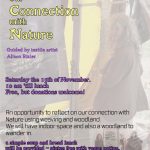 We will be gathering to give people the opportunity to reflect on their connection with Nature. We will have indoor space and also a woodland to wander in. We will be guided by textile artist Alison Bixler. Don’t worry if you know nothing about weaving, or #SensingSpirituality. You were born for this! We plan to… Read more: Weaving Our Connection with Nature
We will be gathering to give people the opportunity to reflect on their connection with Nature. We will have indoor space and also a woodland to wander in. We will be guided by textile artist Alison Bixler. Don’t worry if you know nothing about weaving, or #SensingSpirituality. You were born for this! We plan to… Read more: Weaving Our Connection with Nature
A general introduction to Forest Church
The following introduction to “Forest Church – a field guide …” starts to answer the question “What is Forest Church”.
(For a more complete discussion on the theme, please read the book!)
“A simple definition might be a group of people, outside, connecting with nature and worshipping God – but I don’t think that quite captures the magic, so a bit more detail is needed. Forest Church isn’t just normal church happening outside; instead it attempts to participate with creation.
We aim to learn, worship, meditate, pray and practice with the trees, at the spring, along the shore. Participants come with an attitude of experimentation, playfulness and readiness to connect with nature. God is present in creation and can be understood through creation; you’re in the sermon, the readings come from the Second Book of God.
The worship will happen when your heart is caught up in the beauty of the moment.
Forest Church is a fresh expression of church drawing on much older traditions when sacred places and practices were outside – but it is also drawing on contemporary research that highlights the benefits of spending time in wild places.
Already there are a few distinct versions of Forest Church emerging. Some people are taking a structured and liturgical approach to their events, others are simply providing a space with very little structure. Some people are facilitating groups who are strong on meditative or ritualistic practice, others have more of a field ecology focus on the flora and fauna around them. Some people are offering something distinctly Christian, some are at the fringes. Some groups meet for an hour and a half, some meet all day. Some groups are influenced by location and have to take into consideration the dangers of their local environment and the creatures living there. The setting might be rural or urban, Forest Church isn’t bound by location; it’s as possible in the city as in the middle of nowhere. And, no, you don’t need a forest.
Having said all that, I would argue that there are, or should be, some central ideas underpinning a generic understanding and description of Forest Church.
• Safety first – Forest Church should be safe to go to. Think about any hazards in the environment you’re going to and the safety of individuals. And consider the safety of the environment from your visiting it.
• It happens outside, in nature – In challenging weather, with a new group, it is hard not to move inside if there is that option but get the clothing, setting and activity right and weather doesn’t matter so much.
• Participate with nature – The aim isn’t to go into nature as if it is something separate from us, the idea is to let the barriers drop; to be with nature. This is explored more in Chapter 3.
• Events are site-specific – Gatherings should relate to, and be in dialogue with the specific setting they’re in. If what is happening could have happened inside, it might be wonderful but it isn’t really Forest Church.
• Allow time for nature to contribute – Nature speaks when it wants to. Build flexibility into events to allow this interaction to happen. This will develop as your group does – adults especially have to relearn the ability to listen but children do it naturally and in many ways are our teachers as far as nature connection goes.
• Recognises that God is revealed in nature – Since the creation of the world God’s invisible qualities – God’s eternal power and divine nature – have been clearly seen, being understood from what has been made (from Romans 1). T he idea is that we can explore the characteristics of the Creator by exploring the creation.
• God speaks through nature – Also recognise that God speaks through nature – we may need discernment and practice to hear and interpret meaning but nature is a source of Divine revelation (more in Chapter 2 on this).
• Aim to be regenerative in practise – Forest Church should try to mend some of the damage humankind has done to the natural world without making things worse. Picking up more litter than we drop is a simple example, as is offsetting any carbon spent by the event.
• In the Christ Tradition – Your wording might be different to mine but the intention of those operating under the Forest Church banner (via www.forestchurch.co.uk) is for Forest Church to have a Christ-centred vision at its core.
There are various expressions of Forest Church, from occasional events hosted by an existing church, to groups that operate independently. For these groups it may be relevant to explore the question ‘is it church’? That all depends on how you define ‘church’, but there isn’t anything that a traditional church can do, such as worship, fellowship, teaching, prayer, discipleship and the sacraments, (communion and baptism for example), that can’t be done by Forest Church – although how to do all of that isn’t covered in this book.
The potential for Forest Church is exciting. They’re free to set up; they’re fairly easy to start and potentially free to run. They are open to, and attract, a diverse group of participants, some of whom wouldn’t attend a traditional church.”

